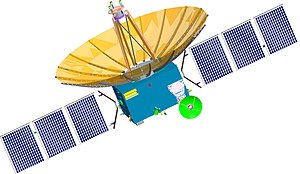 Rendering of Queqiao 2 satellite | |
| Mission type | Communication relay Radio astronomy |
|---|---|
| Operator | CNSA |
| COSPAR ID | 2024-051A |
| SATCAT no. | 59274 |
| Mission duration | Planned: 8-10 years 4 months, 16 days (in progress) |
| Spacecraft properties | |
| Bus | CAST-2000[1] |
| Manufacturer | DFH Satellite Company LTD |
| Dry mass | 1,200 kilograms (2,600 lb) |
| Dimensions | Antenna: 4.2 metres (14 ft) in diameter[1] |
| Power | 1350W[1] |
| Start of mission | |
| Launch date | 20 March 2024, 00:31:28 UTC[2] |
| Rocket | Long March 8[2] |
| Launch site | Wenchang LC-201[2] |
| Orbital parameters | |
| Reference system | Selenocentric frozen orbit |
| Periselene altitude | 200 km (120 mi)[3] |
| Aposelene altitude | 16,000 km (9,900 mi)[3] |
| Inclination | 62.4°[4] |
| Period | 24 hours[3] |
| Lunar orbiter | |
| Orbital insertion | 24 March 2024, 17:05 UTC[5] |
| Instruments | |
| |
Queqiao satellites | |
Queqiao-2 relay satellite (Chinese: 鹊桥二号中继卫星; pinyin: Quèqiáo èr hào zhōngjì wèixīng; lit. 'Magpie Bridge 2 relay satellite'), is the second communications relay and radio astronomy satellites designed to support the fourth phase the Chinese Lunar Exploration Program,[6][7][8] after Queqiao-1 launched in 2018. The China National Space Administration (CNSA) launched the Queqiao-2 relay satellite on 20 March 2024 to an elliptical frozen orbit around the Moon to support communications from the far side of the Moon and the Lunar south pole.[9][10][11][12]
The name Queqiao (ch'wuh-ch'yow, "Magpie Bridge") was inspired by and came from the Chinese tale The Cowherd and the Weaver Girl.[9][8][13]
- ^ a b c Cite error: The named reference
final-designwas invoked but never defined (see the help page). - ^ a b c "China launches Queqiao-2 relay satellite to support moon missions". Spacenews.com. 19 March 2024. Retrieved 20 March 2024.
- ^ a b c Lihua Zhang (2024-03-20). "月亮之上"梦想绽放" 增强现实+AI生成技术揭秘鹊桥二号发射全程" (in Simplified Chinese). 央视网. Retrieved 2024-03-23.
- ^ 周文艳、高珊、刘德成、张相宇、马继楠、于登云 (2020). "月球极区探测轨道设计" (PDF). 深空探测学报. 7 (3): 250.
- ^ "鹊桥二号中继星成功实施近月制动 顺利进入环月轨道飞行" (in Simplified Chinese). 新华网. 2024-03-25. Retrieved 2024-03-25.
- ^ Cite error: The named reference
:4was invoked but never defined (see the help page). - ^ "成功!". Weixin Official Accounts Platform. Retrieved 2024-03-20.
- ^ a b Lihua, Zhang (2024-03-02). "Development and Prospect of Chinese Lunar Relay Communication Satellite". SPACE: SCIENCE & TECHNOLOGY.
- ^ a b Cite error: The named reference
space-wallwas invoked but never defined (see the help page). - ^ "Queqiao". NASA.
- ^ "嫦娥六号或明年5月发射 实现月球背面采样返回 | 联合早报". www.zaobao.com.sg (in Simplified Chinese). Retrieved 2024-03-20.
- ^ "Sina Visitor System". passport.weibo.com. Retrieved 2024-03-20.
- ^ "鹊桥二号中继星计划明年发射 --科技日报数字报". digitalpaper.stdaily.com. Retrieved 2024-03-20.
© MMXXIII Rich X Search. We shall prevail. All rights reserved. Rich X Search
